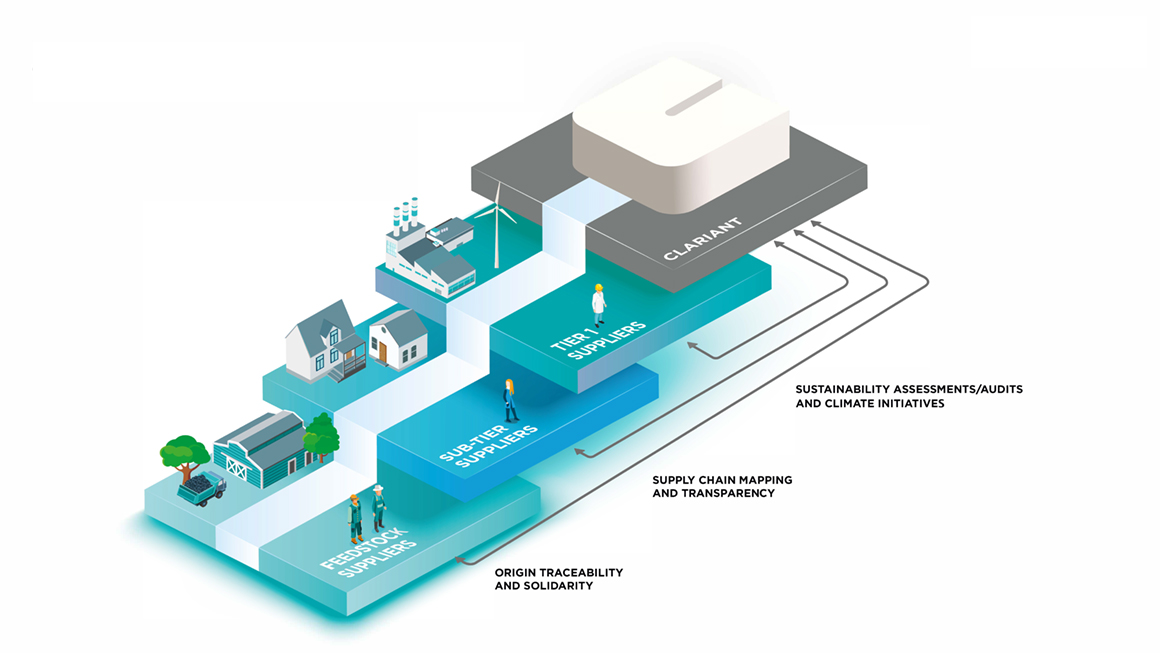Holistic management approach
In a more and more globalized value chain, balancing cost efficiency and a high level of quality, ecological and social standards with a sustained security of supply is a major challenge. Increasingly closer relationships with suppliers and customers offer opportunities to create sustainable value with secure, high value-added value chains. At the same time, the supply chains at procurement may be exposed to potentially significant risks. Clariant is fully committed to continuously reducing these risks, by sourcing responsibly and therefore, increasing the sustainability in its supply chain.
Our commitments
In order to underline its commitment to sustainability, among other integral parts of our business strategy, Clariant developed a Code of Conduct for Suppliers which is binding. We expect our suppliers and contractors globally and locally to comply with this Supplier Code of Ethics and to work hand in hand with us in meeting future sustainability challenges.
A strong example of our commitment to sustainability is our membership, since 2014, in Together for Sustainability (TfS). TfS is a joint initiative of more than 30 chemical companies, with a mission to drive sustainability performance evaluations and improvements across chemical supply chains. The TfS framework consists of online supplier sustainability assessments run by the service provider EcoVadis, as well as on-site supplier sustainability audits run by specialized auditing companies. Participation in Together for Sustainability enables Clariant to improve transparency and efficiency and lower risks in its procurement process.
Learn more about our collaboration with Together for Sustainability here.

Capability building
Ensuring continuous training among suppliers and those responsible for sourcing
Active supplier communication and engagement is an essential element of Clariant’s supply chain sustainability strategy. Standard responsible sourcer and supplier toolkits are regularly updated. In addition, Clariant Procurement systematically engages with suppliers in key sourcing markets, such as China, Brazil, and India to explain the company’s sustainability efforts, strategy, and expectations of suppliers via dedicated external training and webinars.
Clariant organizes internal training initiatives on a quarterly basis to increase awareness and enhance its staff capability to evaluate sustainability performance in our supply chain. The training mainly targets employees within the Global Procurement Services (GPS) organization and business unit associates. The focus is on improving processes and structures, as well as coaching on supplier sustainability engagement best practices. Learning plans are designed to help employees to develop the competences that will help them excel in their current (and even future) roles.
Performance
Sustainable supply chain indicators
Clariant maintains a comprehensive and detailed supplier information database enabling a wide variety of analyses on both commercial and non-commercial Key Performance Indicators (KPIs). These non-commercial indicators enable us to track supplier performance in terms of not only of criteria such as quality, service, and e-procurement matter, but also sustainability.
Key Figures
2015 2016 2017
2018 2019
2020
2021 2022 2023 3rd Party Sustainability Assessments1
Percentage of direct spend (raw materials) covered 53% 63% 65% 74% 78%
80% 86% 89% 91% Number of shared Sustainability Assessments1 4442 6383
8692 10566 12200
11500 11167 13472 16902 3rd Party Sustainability Audits2 Number of shared Sustainability Audits 321
403
441
358 309 258 284 378 492
Automation rate3 58% 63% 65% 70% 73% 73.4% 69.7% 67.6% 68.8%
Key supplier performance evaluation direct spend /
indirect spend442% 65% 75% 82% 85% 88% 94%/
92%89.8%/
72.9%
Procurement workforce development5 <40% >90% >97% >97% 97%
96% 97% 94% 93%
1 Based on TfS supplier assessments2 Based on TfS supplier audits3 Automation Rate: Fully automated (Zero Touch) order processing of all Indirect Spend, % based on transactions4 Percentage of evaluated suppliers mostly with threshold of CHF 1 million5 Share of Procurement employees with personalized knowledge assessment and individual learning plan
Go to our Integrated Report to view the latest key figures on sustainability assessments, environmental performance and mitigating actions in our supply chains.

